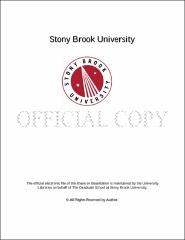| dc.identifier.uri | http://hdl.handle.net/11401/76963 | |
| dc.description.sponsorship | This work is sponsored by the Stony Brook University Graduate School in compliance with the requirements for completion of degree. | en_US |
| dc.format | Monograph | |
| dc.format.medium | Electronic Resource | en_US |
| dc.language.iso | en_US | |
| dc.publisher | The Graduate School, Stony Brook University: Stony Brook, NY. | |
| dc.type | Dissertation | |
| dcterms.abstract | Contrast agents have been routinely employed in radiographic applications for more than 80 years and in computed tomography (CT) for more than 50 years. These agents have high atomic number increasing the photoelectric interaction probability thereby reducing photon intensity projected through the contrast containing structure and improving available image contrast. A wide variety of contrast agents have been examined over the years, however, iodine and barium containing agents make up the vast majority of applications. Other agents are or may become available which may find utility due to reduced toxicity, better characteristics for imaging or dose reduction. This is particularly true as computed tomography based angiography (CTA) replaces conventional angiography for diagnostic applications. The purpose of this dissertation is to develop a frame work for the evaluation of new and future contrast agents as they apply to CT enhancement including CTA. The contrast agent evaluation model developed in this dissertation allows for the examination of potential new contrast agents as well as the optimized use of existing contrast agents. Optimization is accomplished by examining the impact of kilovoltage and filter combinations on image quality and radiation dose. In this way the minimum concentration of contrast agent, at a given radiation dose, can be determined. The approach taken was to model the spectra from an x-ray tube at a specified kilovoltage, compute the spectra after filtration and project the computed spectra through a cylindrically symmetric head phantom (16 cm diameter solid water) with a contrast containing target at its center. Noise was applied to projection data based on photon counting. Standard filtered back projection applied to the projection data provides a simulated image from which image contrast-to-noise ratio (CNRi) can be determined. Alternatively, the projection data contrast-to-noise ratio (CNRp) can be scaled with an empirically derived factor that accounts for propagation of error and other sources of error in the image formation process to obtain the CNRi. Radiation dose at the center of the phantom was computed from photon fluence attenuated by 8 cm of water and empirically corrected for scatter radiation. An arbitrary target CNRi of unity was selected and allowed for calculation of the target contrast agent concentration that resulted in a CNR of unity per unit radiation dose. We have defined the resulting contrast agent concentration as the minimum effective concentration (MEC). With this model the impact of x-ray beam kilovoltage and filtration on MEC can be determined by computation, thereby allowing for their optimization. The model has been validated with a phantom using direct measurement of dose and contrast using a clinical CT system. From the contrast agent evaluation model, an improved understanding of the potential to optimize iodine contrast enhancement was gained. Likewise, the potential use of gadolinium as a CT contrast agent has been recognized. Finally the contrast agent enhancement model has been used to predict how gadolinium enhanced CT can be greatly improved through the use of the appropriate kilovoltage and filter combination. | |
| dcterms.available | 2017-09-20T16:51:33Z | |
| dcterms.contributor | Button, Terry M | en_US |
| dcterms.contributor | Dilmanian, F. Avraham | en_US |
| dcterms.contributor | Jambawalikar, Sachin. | en_US |
| dcterms.contributor | Zhao, Wei | en_US |
| dcterms.creator | Bonvento, Michael Joseph | |
| dcterms.dateAccepted | 2017-09-20T16:51:33Z | |
| dcterms.dateSubmitted | 2017-09-20T16:51:33Z | |
| dcterms.description | Department of Biomedical Engineering | en_US |
| dcterms.extent | 115 pg. | en_US |
| dcterms.format | Application/PDF | en_US |
| dcterms.format | Monograph | |
| dcterms.identifier | http://hdl.handle.net/11401/76963 | |
| dcterms.issued | 2016-12-01 | |
| dcterms.language | en_US | |
| dcterms.provenance | Made available in DSpace on 2017-09-20T16:51:33Z (GMT). No. of bitstreams: 1
Bonvento_grad.sunysb_0771E_12766.pdf: 1875135 bytes, checksum: 3b641bf5465dcc3caa0321323ee85c7a (MD5)
Previous issue date: 1 | en |
| dcterms.publisher | The Graduate School, Stony Brook University: Stony Brook, NY. | |
| dcterms.subject | Computerized Tomography, Contrast Agents | |
| dcterms.subject | Biomedical engineering | |
| dcterms.title | Evaluation of Contrast Agents Used in Computed Tomography | |
| dcterms.type | Dissertation | |

